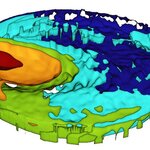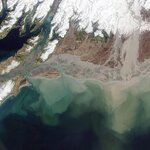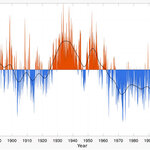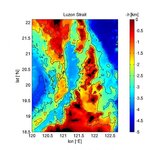Oceanography

Observations of Greenland's Helheim Glacier link the process through which chunks of ice at the edge of a glacier break away, which has been hard to study, to seismically detectable events known as glacial earthquakes, which have been increasing in number in recent years.
Because seismic signals from these events can be detected by instruments located all over the globe, it should be possible to use glacial earthquakes as proxies for the glacier edge breaking process, known as calving.
This is an important development since so few direct observations of the calving process are available,…

Scientists have developed a computer model that clarifies the complex processes driving ocean mixing in the vast eddies that swirl across hundreds of miles of open ocean.
The Lagrangian In-situ, Global, High-performance particle Tracking (LIGHT) model is a first-of-its-kind tool because of its ability to exploit the power available from today's supercomputers, the authors say.
Global climate simulations are beginning to be able to resolve the largest ocean eddies, called mesoscale eddies, which are considered the "weather" of the ocean. The model that the Laboratory researchers developed for…

New research shows that surface waters of the Chukchi and Beaufort seas could reach levels of acidity that threaten the ability of animals to build and maintain their shells by 2030, with the Bering Sea reaching this level of acidity by 2044.
"Our research shows that within 15 years, the chemistry of these waters may no longer be saturated with enough calcium carbonate for a number of animals from tiny sea snails to Alaska King crabs to construct and maintain their shells at certain times of the year," said Jeremy Mathis, an oceanographer at NOAA's Pacific Marine Environmental…

Over geologic time, the work of rain and other processes that chemically dissolve rocks into constituent molecules that wash out to sea can diminish mountains and reshape continents.
Scientists are interested in the rates of these chemical weathering processes because they have big implications for the planet's carbon cycle, which shuttles carbon dioxide between land, sea, and air and influences global temperatures.
A new study, published online on June 8 in the journal Nature Geoscience, by a team of scientists from Stanford and Germany's GFZ Research Center for Geosciences reveals that,…

Though ocean acidification and corals have been a concern, not all coral reefs are at risk. Instead, some thrive as they have absorbed atmospheric carbon dioxide (CO2) released by the burning of fossil fuels.
In ocean acidification, the CO2 reacts with water molecules, lowering ocean pH (making it more acidic), and that process also removes carbonate, an essential ingredient needed by corals and other organisms to build their skeletons and shells.
World Oceans Day today has meant new questions about ocean acidification, which threatens coral reef ecosystems worldwide - but not all reefs.…

Currently different data formats between research centers pose a challenge to oceanographic researchers, but a new project is going to make marine data sets more easily accessible to researchers worldwide.
The ODIP II project will use NERC’s vocabulary server to ‘translate’ between these different data semantics. ODIP II is a collaboration between the USA, Australia and the EU. By the time it is complete, in May 2018, it aims to have developed a means of seamlessly sharing and managing marine data and coordinating the existing regional marine e-infrastructures.
The Head of BODC Dr…

The Atlantic Ocean’s surface temperature swings between warm and cold phases every few decades. Like its higher-frequency Pacific relative El Nino, this so-called “Atlantic Multidecadal Oscillation” can alter weather patterns throughout the world.
The warmer spell we’ve seen since the late 1990s has generally meant warmer conditions in Ireland and Britain, more North Atlantic hurricanes, and worse droughts in the US Midwest.
However a colder phase in the Atlantic could bring drought and consequent famine to the developing countries of Africa’s Sahel region. In the UK it would offer a brief…

A new analysis of the stability of the Antarctic ice sheet shows that ice rises (pinning points that keep the floating parts of ice sheets in place) are formed during the transition between glacial and interglacial periods, which significantly slows down the response of the ice sheet to climate change.
The Antarctic ice sheet holds enough ice to potentially raise global sea levels by 67 meters, though even the most outrageous gray literature in IPCC reports does not claim that can happen. Many questions still arise regarding its reaction to climate change, especially for the marine…

When you mention rich ecosystems that are vital for life on Earth, people tend to think of rainforests, but ocean plankton are actually just as crucial. The microscopic beings that drift on the upper layer of the oceans are globally referred to as "plankton"; together they produce half of our oxygen, act as carbon sinks, influence our weather, and serve as the base of the ocean food web that sustains the larger fish and marine mammals that we depend upon or draw delight from.
"Beyond the cutting-edge science that was developed thanks to our collaborative work with the Tara Expéditions…

We've all been captivated by ocean waves, we accept (everyone except Galileo anyway) that the moon has an impact on tides and waves, but less well known is that the ocean contains rolling internal waves beneath the surface that displace massive amounts of water and push heat and vital nutrients up from the deep ocean.
These internal waves have long been recognized as essential components of the ocean's nutrient cycle, and key to how oceans will store and distribute additional heat brought on by global warming. Yet thorough understanding of how internal waves start, move and…